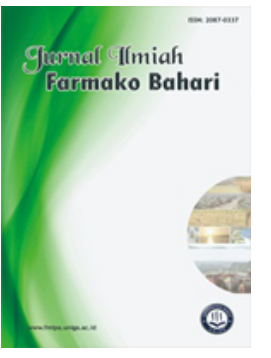
MOLECULAR DOCKING STUDY OF XANTHONE DERIVATIVE COMPOUNDS OF MANGOSTEEN RIND (Garcinia mangostana L.) TO ER-α (ESTROGEN RECEPTOR ALFA) AND ER-β (ESTROGEN RECEPTOR BETA) AS ANTI-BREASTCANCER

- Jurnal Nasional Terakreditasi
- Riska Prasetiawati, Benny Permana, Dang Soni, Sakti Nunggal Agung
- Jurnal Ilmiah Farmako Bahari Vol.9 ; No. 1; Juli 2018 Halaman 45-52 P-ISSN: 2087-0337 E-ISSN: 2715-9949
Abstrak
Abstract
In silico study, research on xanthone compounds derived from mangosteen rind
(Garcinia mangostana L.) has shown various pharmacological activities. This
research is an experimental study using a computer-assisted device, the
AutoDockTools software (version 1.5.6) with the intention ofto obtain the
xanthone derivativecompounds as the best candidates for anti-breastcancer
drugs through molecular docking. The docking of 41 xanthone derivative
compounds has been carried out on ER-α (estrogen receptor alfa) and ER-β
(estrogen receptor beta) using the molecular docking simulation method with
AutoDockTools (version 1.5.6), visualized used Discovery Studio Visualizer,
pharmacokinetic analysis and toxicity compound used pre-ADMET software. The
molecular docking results show that two anticancer compounds as lead
compound to ER-β, namely Demetilcalabaxanton has a lowest free energy
binding value of -10.36 kcal/mol with amino acid residues Thr347, Met343 and
Trapezifolixanton has a lowest free energy binding value of -10.37 kcal/mol with
amino acid residues Glu305 has better potential than comparative drugs
tamoxifen -8.54 kcal/mol and clomiphene -8.87 kcal/mol. Basedon the results
analysis prediction, lead compound demetylcalabaxanton, and trapezifolixanton
compounds have pharmacokinetic profile: good with Caco-2 values of 17,63 and
4,036; HIA 94,35% and 93,38%; PPB 95,63% and 91,53% than results from
toxicity obtained results,neither carcinogenic nor mutagenic.
Key words: Anticancer, estrogen receptor beta, mangosteen rind, molecular
docking, xanthone
Lihat Dokumen
